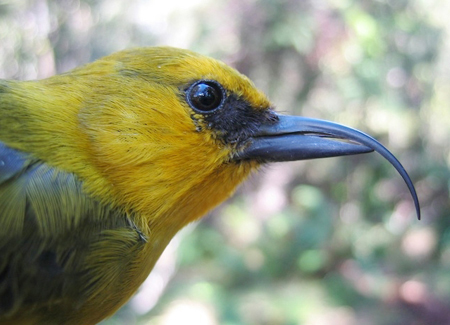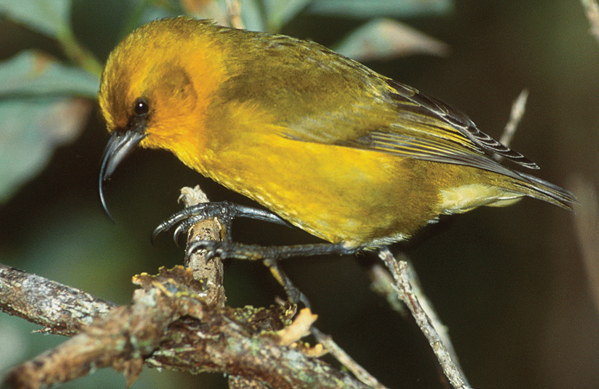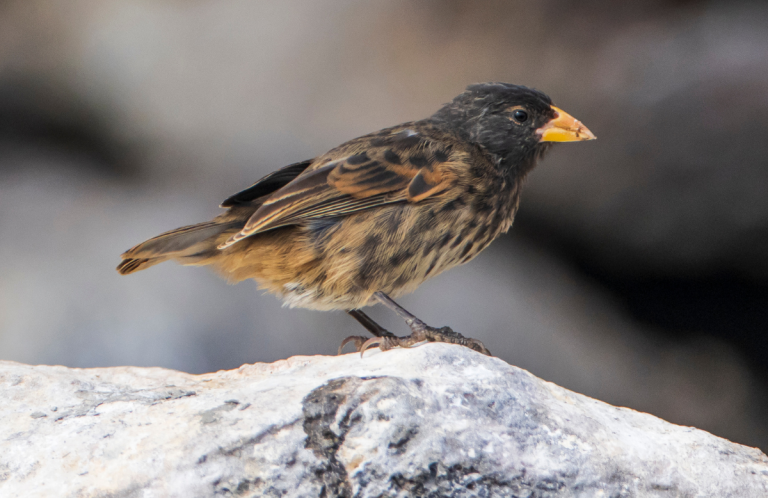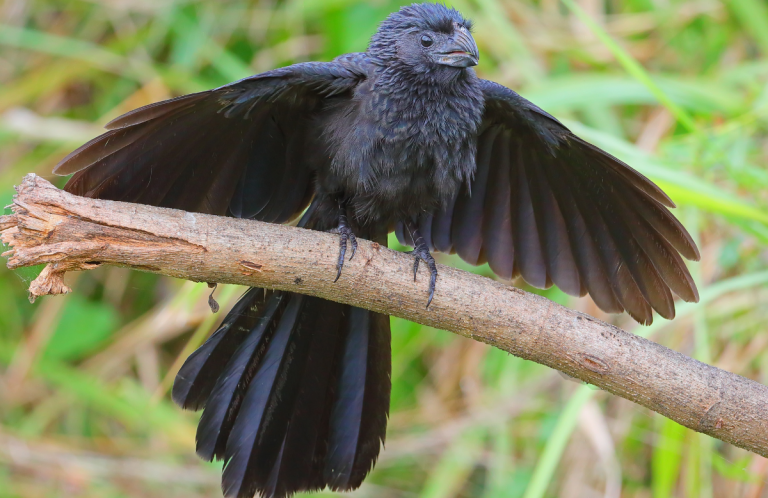
Map courtesy of “Birds of North America” https://birdsna.org, maintained by the Cornell Lab of Ornithology, Ithaca, NY
The ʻAkiapolaʻau (pronounced ah-kee-ah-POH-LAH-OW) has one of the most unusual bills in the Hawaiian honeycreeper family, with a long, downward-curving upper mandible, used for probing, and a shorter lower mandible that functions as a chisel. This specialized bill allows the species to exploit the same niche occupied by woodpeckers in other parts of the world. ʻAkiapolaʻau even make woodpecker-like tapping sounds as they forage along tree limbs in search of insects.
The chief threats to this golden-yellow bird are habitat loss (particularly of native koa trees), predation by introduced mammals such as rats and cats, and non-native avian diseases spread by introduced mosquitoes, which restrict it to high altitudes. Global climate change will allow mosquitoes to move to even higher elevations, further decreasing suitable habitat for the ʻAkiapolaʻau and other endangered Hawaiian endemic birds such as 'I'iwi.
Hiding in the Heights
The ʻAkiapolaʻau was fairly abundant and widely distributed on the island of Hawai'i (the “Big Island”) until the 1970s. Since then, both its range and abundance have severely declined, and it is now only found in high-elevation forests. The species was listed as endangered in 1967 under the Endangered Species Act.
Sign up for ABC's eNews to learn how you can help protect birds
Double-duty Beak
The ʻAkiapolaʻau's distinctive beak serves as a multi-use tool, allowing the bird to feed in several different ways. It uses the straight lower part of its beak to peck holes in bark, then probes with its long, curved upper bill to extract insects. It also drills holes for sap, particularly in the legendary ʻohi'a trees. This honeycreeper favors native koa forest for foraging, creeping along tree trunks and branches somewhat like a North American nuthatch.
Individuals are faithful to certain trees, with males feeding on the trunks and large branches and females creeping along small branches and twigs. Males have slightly longer bills, enabling them to peck into the thicker bark of larger branches.
Nesting Behind a Picket Fence
Female ʻAkiapolaʻau show a strong preference for 'ohi'a trees as nest sites. They build their nests using strips of ‘ohi‘a bark, incorporating a unique “picket fence” rim. The strips of bark protruding around the perimeter may help camouflage the nesting female from hawks and other predators.
Unlike the prolific Hawai'i 'Amakihi, the ʻAkiapolaʻau only lays one egg during its nesting season and then cares for its fledgling for at least 4 to 5 months. This low reproductive rate makes the species particularly vulnerable to threats and slow to recover.

The marvelous beak of the ʻAkiapōlāʻau is a multi-purpose tool; the short lower mandible is used as a chisel, while the long, curved upper mandible acts as a probe. Photo by Josh Engel
ABC supports Hawaiian partners in protecting and restoring important habitat on the Big Island for ʻAkiapolaʻau and other native birds such as Palila. Fencing and removal of hoofed mammals, such as non-native sheep, are critical conservation actions used at Hakalau Forest National Wildlife Refuge, the first refuge established solely for the Hawaiian forest birds and a key stronghold of ʻAkiapolaʻau.
ABC's partners have built fencing on upper elevations of Mauna Kea volcano, where overgrazing by sheep severely degraded native mamane forests. The Hawai'i Division of Forestry and Wildlife (DOFAW) is conducting an eradication program to remove sheep from fenced areas; ABC and the Mauna Kea Forest Restoration Project (MKFRP) continue work to restore habitat by planting trees, tracking habitat recovery, and surveying bird numbers.
ABC recently joined with several partner groups to ask Congress to support a new conservation effort in Hawai'i that would provide increased funding for endangered endemic birds. Together with our partners, we're undertaking many other conservation efforts bring Hawaiian birds back from the brink of extinction.
Donate to support ABC's conservation mission!



















































